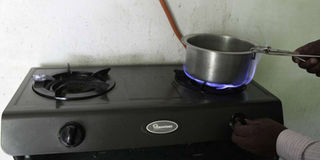What to consider when setting up biogas unit

A biogas-powered cooker in use. A good fixed dome biogas unit constructed by a qualified technician can last for as long as 50 years. FILE PHOTO | NMG
What you need to know:
- The formula for calculating the size of plant is: Cow dung/cow/day multiplied by number of cows multiplied by two multiplied by 60, then divide all by 1,000.
- You need to look at safety, costs and management.
- Any leakage along the system should also be attended to promptly.
- Extra storage facilities are not required in the fixed dome biogas system because it has its own storage device known as the displacement mechanism.
A farmer who intends to install a small scale biogas system (6-32m3) has a number of considerations to make. This includes and not limited to: the design of the unit, its capacity, how much gas to expect from the plant, cost of the system, safety of the gas, management of the system and how to store excess gas.
Design of biogas plant
A good biogas digester must resemble the stomach with an inlet, an outlet and the ability to stir the materials as it grids them.
There are three major designs of biogas plants, namely, the fixed dome, floating drum and flexible bag. The fixed dome and the floating drum plants have all the qualities mentioned above.
This makes them more sustainable than the flexible bag designs.
However, the fixed dome plant design has the ease of the day to day operation, low maintenance cost and its ability to produce gas constantly on a daily and annual basis despite the climatic variations.
A fixed dome biogas unit constructed by a qualified technician can last for as long as 50 years. It is therefore recommended that one install a fixed dome biogas unit.
If another unit has to be installed, ensure it has an inlet, outlet, self-stirring mechanism, is protected from climatic variations and is made from a sustainable material.
Capacity/size of the plant/ construction cost
The formula for calculating the size of plant is: Cow dung/cow/day multiplied by number of cows multiplied by two multiplied by 60, then divide all by 1,000.
The figure two indicates the dilution rate as cow dung is mixed with water at a ratio of 1:1 weight: volume before it is fed into a digester, while 60 refers to retention time which is the number of days that the waste is supposed to stay in the digester before all the energy is extracted from it.
The figure 1000 is for purpose of converting the volume in litres to cubic metres which will be used to construct the unit.
For example, if a farmer has four cows with each producing 15kg of waste per day, the size of his digester will be: 15 x 4 x 2x60)/1,000 = 7.2m3. To give an allowance in case of extra waste, this farmer can construct an 8m3 plant.
Recent studies however, have shown that 75 per cent of the waste is digested within 25-30 days.
This means that the retention time can be reduced by half and still get a good amount of gas. The farmer with four animals can thus construct a 4m3 unit instead of the 8m3 one.
This will reduce the construction cost by half. The construction cost of an 8m3 can range between Sh80,000 and Sh100,000 depending on availability of materials.
It can also be less or higher depending on the experience of the technician.
Amount of gas to expect
About 0.5m3 of gas can be generated from the 15kg of dung that one cow produces per day, thus a farmer can estimate the amount of gas in cubic metres per day by multiplying the number of adult cows by 0.5. An efficient biogas burner utilises about 0.5 m3 of gas per hour.
This means that a farmer with four cows and an efficient burner can have four hours of continuous cooking from a single burner.
Safety of the gas
Although biogas is highly explosive when mixed with air, practical experience shows that it is relatively safe considering reported cases of explosions.
However, it is important to be cautious by ensuring that open flames are not permitted within six metres of a biogas plant.
Technicians should also ensure that all biogas is evacuated from a digester before they enter during repair or inspection.
This is because biogas can displace oxygen and cause suffocation. In case of leakage in the house, ensure proper ventilation by opening windows and doors to let out the gas and ensure there is no smell of the same before putting on the burners.
Any leakage along the system should also be attended to promptly.
Management of the system and how to store excess gas
Regular feeding of the digester is recommended for a continuous supply of gas. The feeding frequency could be daily, weekly or twice a week.
If plant is not fed daily, all the waste has to be collected daily and covered with a non-porous material. Canning biogas in a similar way to natural gas is uneconomical due to the high cost of cans and the pumping system.
Extra storage facilities are not required in the fixed dome biogas system because it has its own storage device known as the displacement mechanism.
However, if one has excess gas, you can pipe it to other users and charge them.




